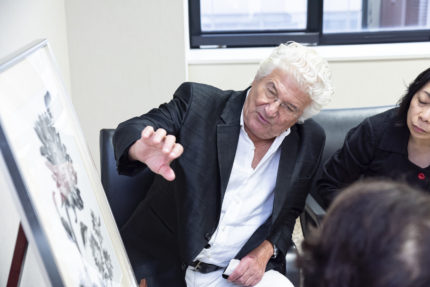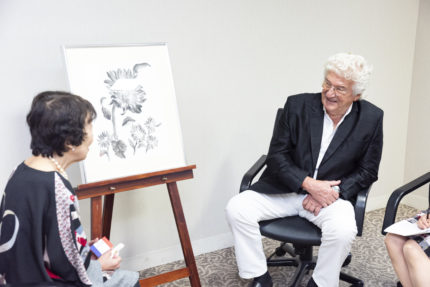- JEPAA Member

- Sumi-Ink
- Ryo Aonuma
- 水墨画
- 青沼良
© 2024 Ryo Aonuma.
SCROLL
Portfolio /作品一覧
- バレリーナ/ballerina
- 記念日/anniversary
- ひまわり/sun flower
view more
Interview article /対談記事
「女流水墨画家とドイツを結ぶ、バレリーナの夢」

クラウス・メンツ・ザンダー(以下、ザンダー):本日は青沼先生にお会いできるということで、すごく楽しみにしていました。水墨画の技術というのは、ドイツでも非常に人気があるんですよ。
青沼良(以下、青沼):ありがとうございます。今日は、展覧会に出品した作品以外にも、いくつか私が描いた絵をお持ちしました。
ザンダー:素晴らしいですね。水墨画という技法で描かれているわけですが、いずれも印象が違いますね。

青沼:作品を描く時は、たいてい自分で直接目にしたものをモチーフにしています。撮影した写真を見ながら描く方もいらっしゃいますが、私はやっていないですね。このぶどうの作品は、私が種まきして、自分で育てたものです。時間がかかりまして、16年目にようやく実が成ったんですよ。こちらは、クンシランと言って、アフリカ原産のランの一種です。葉の色が素晴らしくて、緑が対照的に映えるんです。こちらは植物ではありませんが、ヤマセミという鳥ですね。これは本物ではなく、テレビで見たものなんですが、白黒の飾り羽根のトサカがとても印象的で、これは水墨画で表現できると閃いて、すぐに録画しました。
ザンダー:一枚一枚すごく葉っぱが生きている感じです。優れた表現技術だと思います。陰影によって、光の感じがすごく分かります。水墨は一回描くと塗りつぶすとかそういうことができませんし、一遍に描かなくてはいけないですから、技術も経験も必要ですよね。
青沼:そうですね、それに集中力も要りますね。


ザンダー:ドイツでは、水彩画に長ける画家を、“王様の規則”なんて言うんですよ。水彩画を描ければ他の技法の絵も描けるというような意味合いなのですが、それだけ水彩画は高度な技術だということです。水墨画も、同じことが言えるのではないでしょうか。
青沼:ありがとうございます。出品作のひまわりの絵も、うちで育てたものなんです。孫が小学校でもらってきた種を蒔いて育てたら、美しい花が咲いたんです。
ザンダー:ひまわりの力強い美しさと、その花が咲いた時の素直な喜びの感情を感じる、良い作品ですね。葉っぱの躍動感も出ているのも良いと思いますね。墨のかすれや淡い色合いの部分の表現が見事ですが、やはりこれが水墨画の極みと言いますか、魅力的なところですよね。
青沼:そうですね。水墨画の醍醐味になります。
ザンダー:青沼先生の作品のモチーフは、やはり草花が主体になるんですか?
青沼:庭とか近所の公園とか、そういう身近で直接見られるものを描く中で、花などが多くなりますね。それから、バレリーナはよく描いています。高校生の頃に初めてバレエを見てから好きになりまして、娘や孫にはバレエをずっと習わせていましたよ。私自身も50歳から始めて、7年前まではやっていました。
ザンダー:本当ですか?実は私も、若い頃はバレリーナになりたかったんですよ。色々と悩みながらその夢は断念しましたが、今でもバレエは大好きです。昨年には、バレエダンサーに、ミュージシャンが即興で音楽を合わせて、そしてそれを私が描くという企画を行いました。
青沼:ザンダーさんもバレエを描かれているとは思いませんでした。私は白鳥の湖のオデットを結構描いているんですよ。それから、ドンキホーテなども描いたことがあります。
ザンダー:ミュンヘンでは、毎年、バレエの週間があるんですよ。バレエに関するお祭りというところでしょうか。毎年、たくさんのイベントを行っていまして、なるべく私も全部見るようにしています。とは言え、イベントの数が多すぎてなかなか実際にすべて回るのは難しいんですけどね。
青沼:私は昔、神戸に住んでいたことがあるんですが、その頃にドイツ人の方が経営される会社に勤めていたことがありまして。その時のことがあるので、ずっとドイツという国が好きだったんです。それで本日、ザンダー先生とお話できることも楽しみにしていたのですが、こうして色々な共通点があることを知って、本当にびっくりしましたし、お話しできてとてもよかったです。
ザンダー:それは私も同じ気持ちです。とても興味のあった水墨画の先生にお会いできましたし、バレエについてもお話しできて、とても楽しかったです。ありがとうございました。
(2019年 青沼良×メンツ・ザンダー対談)
“Connecting a female ink artist to Germany and the dream of becoming a ballerin”

Klaus Menz-Sander (hereinafter referred to as “Sander”): I was really looking forward to seeing you today, Ms. Aonuma. The art of ink painting is very popular in Germany as well.
Ryo Aonuma (hereinafter referred to as “Aonuma”): Thank you. Other than the pieces I displayed at the exhibition today, I’ve also brought along some other paintings of mine.
Sander: That’s great. They all give off different impressions despite the fact that the same ink painting technique was used in all of them.
Aonuma: I normally use the things I’ve seen with my own eyes as motifs in my paintings.There are also people who paint while looking at photos. But that’s not something that I do. The grapes seen in this painting were personally planted and grown by myself. Thesewere also the grapes that finally grew sixteen years after the seeds were planted. This one is called a clivia, and it’s a type of orchid that’s native to Africa. The leaves also have a wonderful green color that lends a contrastive charm to the plant. This one isn’t a plant, but a bird called the crested kingfisher. I didn’t see it in person, but on TV. And as soon as I saw it, I immediately recorded it on video since I was very impressed by its black and white crest and thought that I could portray it in an ink painting as well.
Sander: Each and every leaf feels very much alive. I think your technique of artistic expression is excellent here. The feeling of the light can also be understood through the shading. Additionally, since ink paintings cannot be painted in a single stroke and must be painted in one sitting, it’s an art form that requires both skill and experience.
Aonuma: Yes, it also requires concentration.


Sander: In Germany, painters who excel in watercolor paintings are called the “king’s rule,” which means that if you’re able paint watercolor paintings, you’re also able to paint other styles of paintings. So it just goes to show that watercolor paintings are that much of an advanced form of art. But the same can be said about ink paintings too.
Aonuma: Thank you. The sunflowers in another painting I exhibited were also ones that we had grown ourselves. These were the beautiful flowers that bloomed after we planted and watered the seeds that my grandchild got from elementary school.
Sander: This is a wonderful painting where I can sense the powerful beauty of the sunflowers as well as the honest joy you must’ve felt when they bloomed. I also think that the lively feeling of the leaves adds a nice touch. The blurs and light hues of the ink are so beautiful. This sort of artistic expression is wonderful. After all, it’s the best quality and a fascinating aspect about ink paintings.
Aonuma: Yes, it’s the real charm of ink paintings.
Sander: Are the motifs of your works mainly flowering plants?
Aonuma: When painting the things I can see in places nearby such as my garden or the neighborhood park, I do end up painting flowers a lot of the time. I also paint ballerinas often. I first started liking ballet after I saw it for the first time during my high school days. Since then, I’ve consistently made my daughter and grandchildren learn it as well. I, too, picked up ballet at the age of 50 and kept on doing it up until seven years ago.
Sander: Really? I actually wanted to be a ballerina when I was younger too. However, I gave up on that dream after having all sorts of concerns. But even so, I still love ballet. Last year, I even planned on doing a painting of a musician playing improvised music to a ballet dancer’s movements.
Aonuma: I did not think that you’d also be doing ballet paintings. I’ve done quite a few paintings of Odette from Swan Lake and have painted Don Quixote before as well.
Sander: In Munich, there’s a week dedicated to ballet every year. I guess it’s a ballet festival. Each year, many events are held and I always try my best to see them all. However, it’s actually difficult to do that.
Aonuma: I used to live in Kobe a long time ago. During that time, I was also working for a company run by Germans. Because of my experiences back then, I’ve always liked Germany as a country. I was also looking forward to talking to you today and was really surprised to learn that we had many things in common. So I’m very happy that I was able to talk to you.
Sander: I also feel the same way about that. I got to meet the artist of the ink paintings I’m very interested in, and also got to talk to her about ballet. So it was really fun. Thank you very much.
(2019 Talk Session Ryo Aonuma and Klaus Menz-Sander )
Profile /経歴
青沼良 Ryo Aonuma
兵庫県出身
作品出展国遍歴(JEPAA関連事業):ドイツ、フランス、マルタ、カナダ他
Born: Hyogo,Japan
Exhibition of Works(JEPAA): Germany, France, Malta, Canada…





